Types of Desert Flowers (With Pictures and Names) – Identification Guide
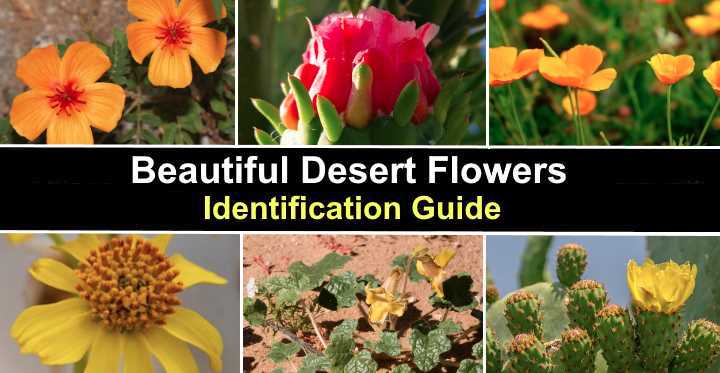
Desert flowers can bloom in the harshest and most arid environments in the country. A range of hardy flowering plants, blooming trees, and flowering cacti can turn a barren landscape into a colorful panorama with shades of yellow, orange, purple, pink, and red. Flowering desert plants are also ideal for beautifying garden landscapes if you live in a hot, dry climate.
Desert flowers are responsible for a spectacular phenomenon that occurs in many deserts — superbloom or desert bloom. This desert flowering event happens after an unusually wet rainy season. Moisture in the ground stimulates the growth and blooming of thousands of desert plants that all produce flowers simultaneously.
Of course, plants that flower and bloom in harsh desert conditions must be tolerant of drought, arid conditions, and constant sunshine. However, choosing the correct hardy plants can help you enjoy the beauty of desert flowers in your front or backyard. But what are the best flowers that bloom in the desert?
This article is an identification guide to choosing desert flowers for your yard. You will find descriptions and pictures of common flowering desert plants, flowering desert trees, and cacti that bloom annually.
Types of Flowers that Bloom in the Desert
Flowering plants in desert areas include California poppies, brittlebush, desert marigolds, and Arizona poppies. Some types of drought-tolerant flowering desert trees are the palo verde, mulga tree, and Anacacho orchid tree. In addition, many types of ornamental desert plants survive arid conditions because they have small, waxy leaves to reduce evaporation.
Desert Flowers (With Picture and Name) – Identification Guide
Desert flowers are native plants that thrive in arid climates where water is scarce. These drought-resistant plants are often found in dry regions in California, Arizona, New Mexico, and Texas. Desert flowers produce beautiful blossoms, and some even produce fruits.
Please read on to learn about plants that will flower in the desert.
Arizona Poppy Flowers (Kallstroemia grandiflora)
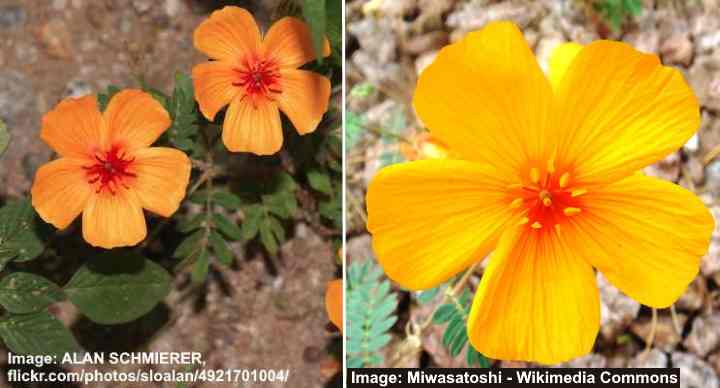
Arizona poppy is a low growing desert flowering plant with small orange or orange-yellow flowers
The Arizona poppy is one of the most spectacular flowering plants in the desert. This annual herbaceous desert plant has five-petalled orange or orange-yellow flowers that bloom abundantly after heavy rainfall. The trailing plant has small, pinnately compound leaves and hairy stems — two characteristic features of many desert flowering plants.
Identifying features of Arizona poppy flowers are the orange-yellow color and their bowl shape. The desert flowers measure 1” to 1.5” (2.5 – 3.8 cm) across and grow on stems 2” to 2.5” (5 – 6.3 cm) long. The small flowering plants are found in deserts in Arizona, Northern Mexico, and California.
Desert Marigold Flowers (Baileya multiradiata)
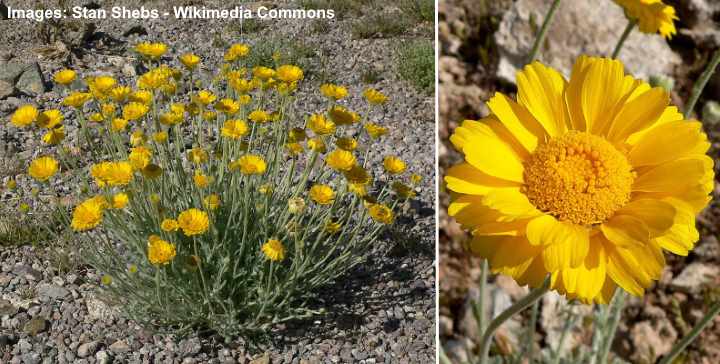
The yellow desert marigold flowers can brighten any desert landscaped garden
The desert marigold flower is identified by its brightly yellow color and disc-like shape. In addition, this short-lived perennial is characterized by silvery green leaves with a matt appearance. As a sun-loving desert wildflower, desert marigold has spreading habits and sometimes grows in clumps.
Yellow-flowering desert marigolds grow up to 20” (50 cm) tall. The easily recognizable feature of the desert plant is its marigold-like flowers measuring 2” (5 cm) across. The flowers bloom in the desert from early spring through late fall. This clumping desert plant thrives in poor, dry soils and hot conditions.
Marsh Aster Flower (Aster pauciflorus)

Marsh aster can be commonly found in desert salt marshes and can grow quite tall
The marsh aster is a common flowering plant found in deserts. The desert flowering marsh aster plant is identified by its disc-like flower head with narrow, spindly petals. The disc florets are typically a purple, lavender, or white color. Typically, 3 to 10 heads grow on stems. Technically a herb, marsh aster is found in the Mojave Desert and throughout the dry southern states.
Marsh aster is a perennial desert plant that spreads through creeping rhizomes. The plant, with its linear foliage, generally grows 12” to 47” (30 – 120 cm) tall. Under ideal conditions, marsh aster flowers from early summer through late fall in salt marshes and salt flats.
Brittlebush Flowers (Encelia farinosa)
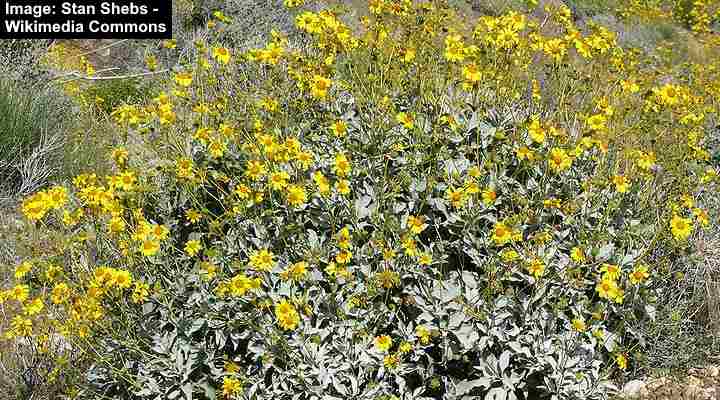
Brittlebush is a yellow flowering desert biome shrub with silvery-green foliage
Brittlebush is a flowering desert plant that has brightly colored yellow flowers arranged as ray florets. During dry, arid conditions in the desert, the plant sheds its leaves. However, it blooms spectacularly after heavy rain. Brittlebush is a classic desert plant and is typically one of the “superbloom” plants in California.
Brittlebush is a mounding shrub with silvery ovate, fragrant leaves. The bushy desert plant grows 12” to 60” (30 to 150 cm) tall. The small daisy-like yellow desert flowers stand erect above the pale green to velvety-silvery foliage.
Brittlebush is a desert plant that is ideal for planting in arid landscapes as a foundation planting, perennial border, or to accent flowering desert trees. In addition, the desert shrub will give gardens a splash of yellow color after rainfall.
Desert Primrose Flower (Oenothera primiveris)
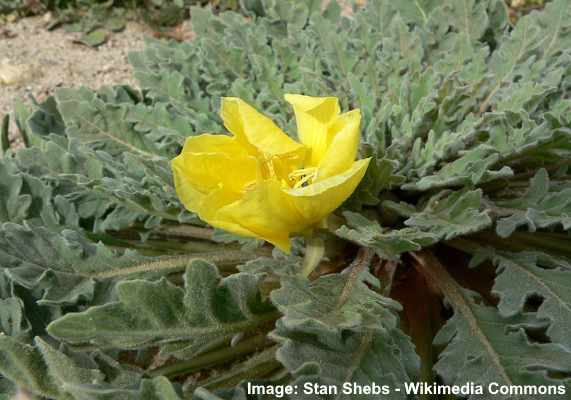
The yellow flowering desert primrose is a common desert plant with crinkly green-gray velvety leaves
Desert primrose is an herbaceous yellow-flowering desert plant with flowers consisting of large, showy golden yellow petals. Desert primrose has a feature of typical desert plants — fuzzy, dull green leaves to help prevent evaporation. The green or grayish leaves grow up to 11” (28 cm) long and are characterized by crinkly margins.
Related to the evening primrose plant, this common desert plant grows 14” (36 cm) tall. Desert primrose flowers have bright yellow color and large petals that are 1.6” (4 cm) long, which emerge yellow and fade to orange or red during the season. The sun-loving, drought-tolerant desert primrose plant is found in the southwestern United States.
California Poppy Flower (Eschscholzia californica)
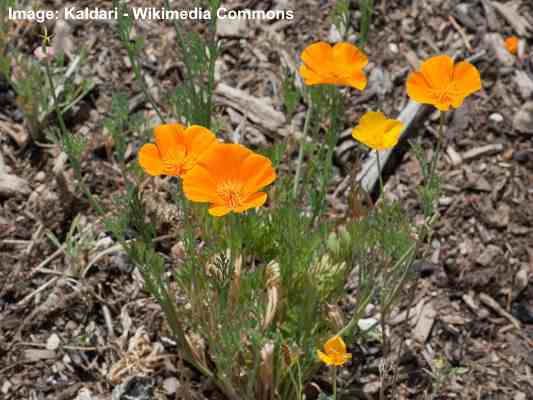
The California poppy is a fast growing desert wildflower with orange flowers that bloom after heavy rain
California poppy is a type of desert flowering plant that is identified by its warm orange cup-shaped flowers. The California poppy is an incredibly tough plant that thrives in desert conditions. The ornamental desert plant has thin green leaves, and spectacular blooming habit after heavy rains. The drought-resistant, self-seeding California poppy plant is ideal for landscaping sunny gardens as a flowering annual.
California poppies are a type of desert flowering plant that grows up to 2 ft. (0.6 m) tall and wide. The bushy plant is characterized by its mounding habit, fast growth, and orange or yellow flowers. This desert flower will bloom in any season after rainfall. The easy-care flowering plant is ideal for planting in arid landscapes.
Apache Plume Flowers (Fallugia paradoxa)

Apache plume is a white flowering desert shrub with feathery plumes that is good for preventing soil erosion
Apache plume is a large desert shrub with pure white flowers, tiny green leaves, and pinkish plume-like styles that remain after flowering. Like many desert plants, the foliage is slightly hairy and has a dull green color. The desert flowers consist of five rounded white petals measuring 2” across.
Apache plume shrubs are related to roses and are native to desert mountains and the southwestern United States. The large shrub grows 3 to 6 ft. (1 – 1.8 m) tall and 6 ft. (1.8 m) wide. Its most recognizable feature is its long feathery plumes emerging from the center of the white flowers.
The clumping Apache plume shrub is ideal for controlling soil erosion. You can also plant this flowering desert shrub in arid landscapes if you want to enjoy white blooms in harsh desert like-conditions.
Devil’s Claw Flower (Proboscidea althaeifolia)
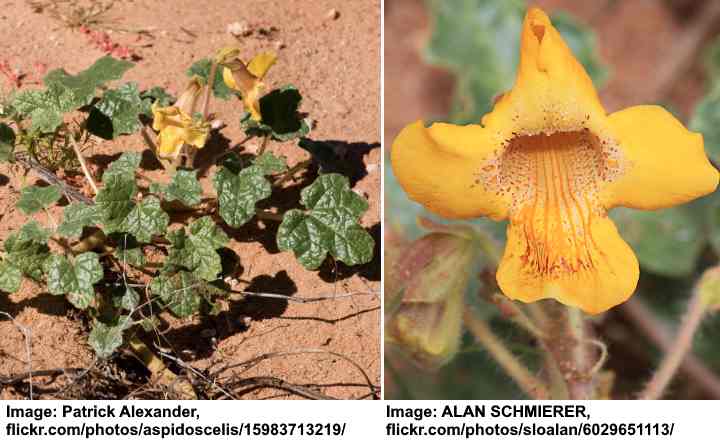
Devil’s claw is a low growing trailing desert flowering plant that can be used as a ground cover in sandy soils
Also called the yellow-flowered devil’s claw, this native desert plant thrives in hot summers and sandy environments. The flowering desert plant is a herb that blooms with fragrant, funnel-shaped orange-yellowish flowers. The creeping herbaceous plant has shiny, oval, or heart-shaped leaves with lobed, wavy margins. It’s a native plant in Arizona, California, and the Sonoran Desert.
The small, low-growing plant grows as a trailing vine in the desert up to 24” (60 cm) wide and 4” (10 cm) tall. Identifying characteristics of the devil’s claw are its large, curled seed pod 2.3” (6 cm) long and trumpet-like orange desert flowers with dark orange lines in the throat.
Fairy Duster Flower (Calliandra eriophylla)
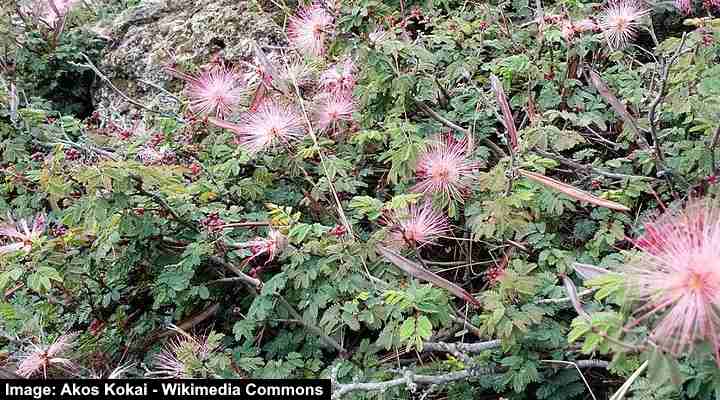
The fairy duster is a pink flowering desert shrub that can be used to landscape arid sunny gardens
Fairy duster is a low-spreading desert shrub with showy desert flowers consisting of pink and white wiry stamens. The winter-blooming flowers consist of clusters of stamens 2” (5 cm) long that fan out, creating a disc shape. The flowers have colorful filaments, adding to their visual appeal.
Fairy duster shrubs grow 1 to 3 ft. (0.3 – 1 m) tall and wide. The small desert shrub is loosely branched with a rounded habit, slow growth, and evergreen foliage. The heat, sun-loving shrub is ideal for informal borders, rock gardens, and dry desert landscapes.
Desert Mariposa Lily Flower (Calochortus kennedyi)
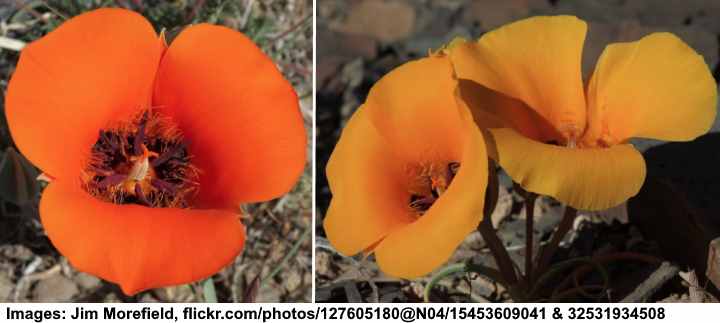
The attractive colorful flowers of the desert mariposa lily can be yellow, orange or red and grow on short stems
The desert mariposa lily is a perennial herbaceous desert plant with three-petalled red, yellow, or orange bell-shaped flowers. The showy desert flowers grow 2” (5 cm) long. The pointed silvery-green leaves measure 4” to 8” (10 – 20 cm) and grow on short, twisting stems up to 20” (50 cm) tall, but typically shorter.
Also called the flame mariposa and red mariposa lily, the desert mariposa lily is a bulbous desert plant that thrives in dry, rocky, well-drained soils. In an arid garden landscape, you can plant the mariposa lily in borders, rock gardens, and mixed beds — anywhere in soil with excellent drainage.
Flowering Desert Trees (With Picture and Name) – Identification Guide
Several types of desert trees thrive in harsh, arid environments. Many trees that grow in the desert also produce spectacular flowers. Here are four kinds of flowering desert trees for your landscape.
Desert Museum Palo Verde (Cercidium x ‘Desert Museum’)
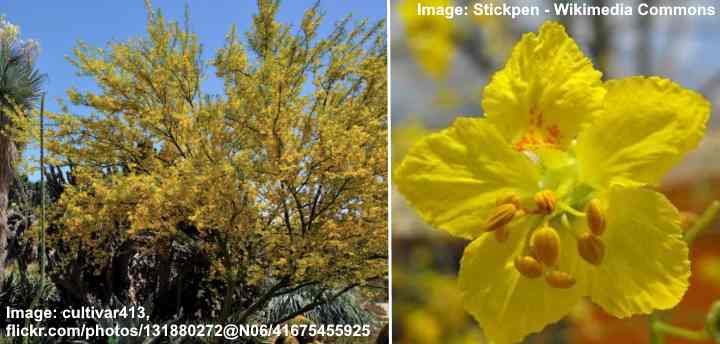
The yellow flowering Desert Museum palo verde tree grows in hot and dry conditions and requires full sun
The palo verde cultivar ‘Desert Museum’ is a fast-growing, small desert tree with an upright vase shape. Despite the hot, arid conditions, the flowering tree blooms in the desert. When in bloom, the tree has spectacular floral displays of large yellow flowers with ruffled petals that persist for several weeks.
Ornamental palo verde ‘Desert Museum’ desert trees are native to the Sonoran Desert. The tree grows up to 25 ft. (7.6 m) tall, and its bark has a characteristic rich green color throughout the year.
In an arid desert landscape, the ‘Desert Museum’ palo verde is ideal as an ornamental flowering tree. Plant the tree in full sun and keep it well-watered until its roots are established.
Chaste Tree (Vitex agnus-castus)

The flowering chaste tree can grow in the arid and hot desert climate and include various cultivars with purple, pink or white flowers
The chaste tree is a heat-tolerant, drought-resistant flowering tree known for its conical purple bottlebrush blooms. The attractive multi-trunk ornamental tree thrives in several habitats, including dry landscapes. Apart from its spectacular lavender sprays, the tree is characterized by its sage-scented palmate leaves and upright habit with densely-growing foliage.
Chaste trees grow 3 to 16 ft. (1 – 5 m) tall, depending on how you prune them. The summer-blooming tree is ideal as a garden or patio tree, adding color and fragrance to a front or backyard. You can also train chaste trees to grow as a shrub border to accent the landscape or plant in a shrub border.
Mulga Tree (Acacia aneura)

Mulga is a shrubby tree with yellow flowers that can be found in the hot and sunny desert climate
The mulga tree is a shrub-like small tree that thrives in desert landscapes. The slow-growing desert tree thrives in the hot sun and rocky soils and survives with occasional watering. The tree blooms with lemon-yellow caterpillar-shaped blooms that complement the silvery gray-green leaves. The tree typically blooms in the deserts after summer rainfall.
The mulga tree is an Australian native tree adapted to desert locations in the southwestern United States. The small desert trees are versatile drought-tolerant trees, ideal for xeric landscapes. Expect the tree to reach 20 ft. (6 m) tall eventually.
Anacacho Orchid Tree (Bauhinia lunarioides)

The white flowering Anacacho orchid is a small tree suitable for desert landscape
Also called the Texas plume, the Anacacho orchid tree is a small flowering tree with eye-catching white flowers. The desert-friendly tree is characterized by its light-green, bi-lobed leaves, orchid-like flowers, and flattened seed pods. In addition, the orchid tree has silvery-gray bark, giving the tree visual appeal when the leaves drop.
The small flowering desert tree grows up to 13 ft. (4 m) tall. The dwarf landscaping tree is useful as a specimen tree in arid landscapes or growing in a container. Its showy flowers and unique foliage make this a spectacular specimen plant.
Flowering Cactus in the Desert (With Picture and Name) – Identification Guide
Flowering cactus plants are the most recognizable of all the hardy plants that grow in the desert. Many species of cacti have flowers that bloom in red, pink, white, orange, and purple shades. And some cactus species bloom regularly, and some very occasionally.
Prickly Pear (Opuntia)
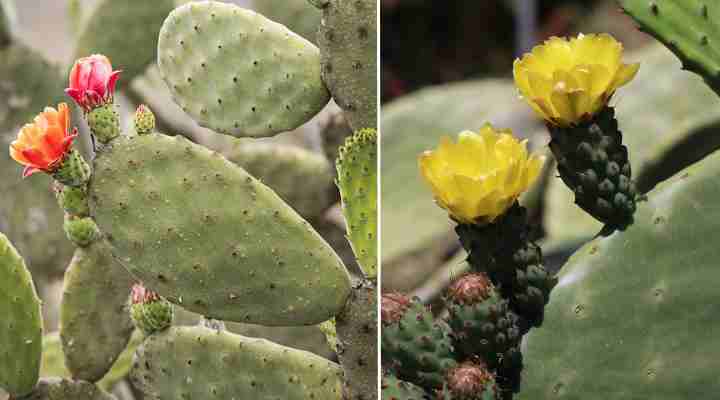
Prickly Pear (Opuntia)
Prickly pear is a species of flowering cactus common in many desert landscapes. Prickly pear cacti are identified by their oval paddle leaves covered in spiny thorns and tiny bristles. Many types of prickly pears bloom with showy, bowl-shaped pink, yellow, red, or orange flowers.
The large pad-like segments of a prickly pear flowering cactus are typically covered in spines. This is a multi-stemmed cactus with bluish-green pads 14” (36 cm) long and 10” (25 cm) wide. After the flowers bloom in the spring, juicy fruits called figs or tunas appear. These desert fruits are 2” to 3” (5 – 7.5 cm) long and taste like watermelon.
Cane Cholla (Cylindropuntia imbricata)
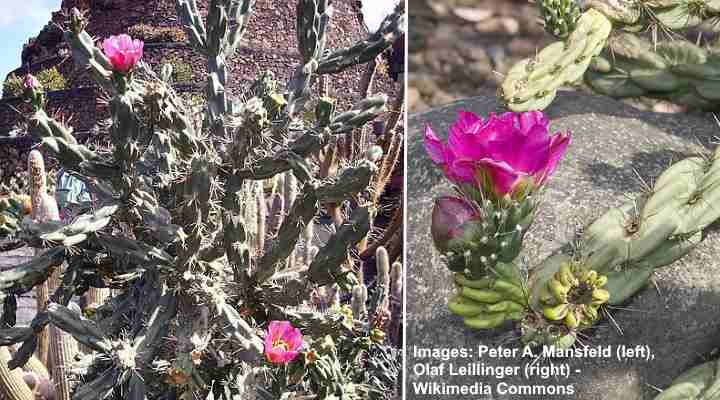
Cane cholla is a sun-loving desert cactus with pink-purple flowers
The cane cholla is a tree-like cactus desert plant with bright pink to purple cup-shaped flowers. These large, showy desert flowers measure 3” (7.5 cm) across. The spiny cactus plant is characterized by its rope-like gray-green stems. Its interesting sculptural shape gives the flowering cactus year-long visual appeal.
The cane cholla cactus grows 3 to 8 ft. (1 – 2.4 m) tall and is commonly found in hot deserts in Texas and the southwestern United States. After the purple-pink flowers bloom, bright golden yellow fruits appear on the spiky stems. The sun-loving cactus is perfect for desert gardens.
Claret Cup Cactus (Echinocereus triglochidiatus)
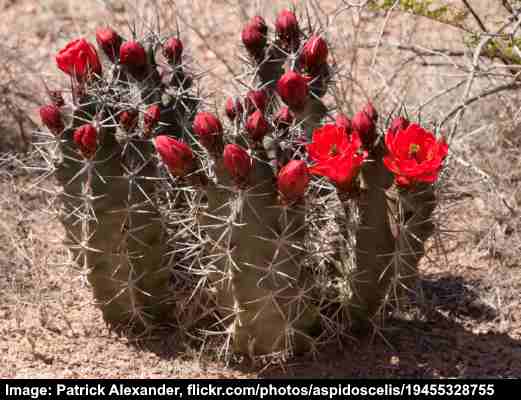
Claret cup is a red flowering cactus that is suitable for desert or rock gardens
Also called the kingcup cactus, this native southwestern flowering cactus has crimson red flowers blooming among spiny stems. The mound-forming cactus plant is identified by its fleshy cylindrical to spherical bluish-green upward-growing stems. These are covered in sharp spikes, and bright red flowers appear from spring until early summer.
Claret cup cacti grow 15” to 24” (37 – 60 cm) tall and create spiky mounds. You can grow the flowering cactus in desert gardens, Mediterranean gardens, and decorative containers. In addition to the bright red flowers, the cactus produces yellow-green, sometimes red, edible fruits.
Blooming Saguaro Cactus (Carnegiea gigantea)
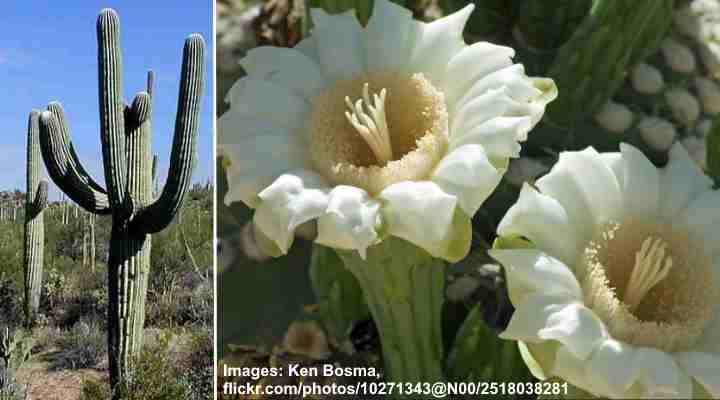
The saguaro cactus is common in desert landscape and has beautiful large white flowers
The flowering saguaro cactus, with its easily recognizable upward-pointing arms, is a classic plant symbolic of the desert landscape. Native to the Sonoran Desert, the saguaro cactus has white, waxy funnel-shaped flowers. These huge flowers grow 3” to 5” (7.5 – 13 cm) long and typically open after sunset. After flowering, ruby red edible fruits appear on the desert cactus.
The columnar flowering desert saguaro cactus grows 10 – 52 ft. (3 – 16 m) tall. However, these flowering cacti are slow-growing plants and may take at least ten years to grow just 1 ft. (0.3 m).
Related articles:
